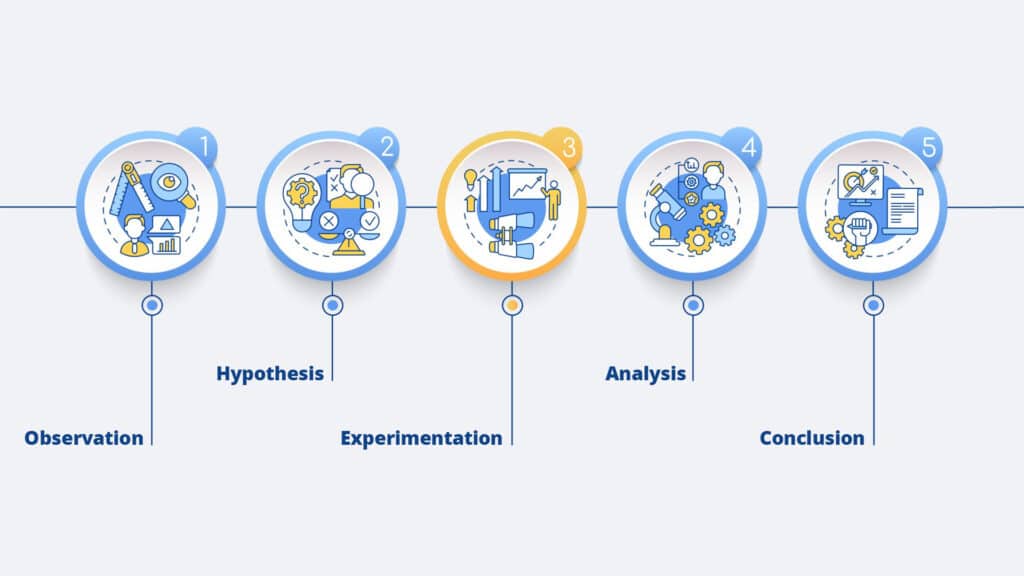The scientific method has its roots in ancient Greece, around the 4th century BCE, with the works of philosophers such as Aristotle, who contributed to the development of empirical research and inductive reasoning. However, the modern version of the scientific method, which emphasizes observation, hypothesis formation, experimentation, and data analysis, emerged more clearly during the scientific revolution of the 16th and 17th centuries. Key figures in this period, like Galileo Galilei, Francis Bacon, and Isaac Newton, significantly refined and formalized the process. So, the modern scientific method is approximately 400-500 years old, while its origins can be traced back more than 2,000 years.
The scientific method has been of paramount importance to humanity’s advancement. Its structured approach to investigating phenomena and solving problems has led to countless discoveries and innovations across various fields, including physics, chemistry, biology, medicine, engineering, and technology. By emphasizing empirical evidence, objectivity, and systematic investigation, the scientific method has facilitated our understanding of the natural world, allowing us to make informed decisions, develop new technologies, and improve the quality of life for millions of people worldwide.
achievements made possible by the scientific method
- The discovery of fundamental laws and principles governing the universe, such as Newton’s laws of motion and the laws of thermodynamics.
- Advances in medical knowledge and treatments, including the development of vaccines, antibiotics, and life-saving surgical techniques.
- The understanding of the structure of atoms and molecules, which has led to groundbreaking technologies in materials science, electronics, and nanotechnology.
- The development of reliable and efficient engineering processes that have revolutionized industries, such as transportation, energy production, and manufacturing.
- The exploration of outer space and our understanding of the cosmos, which has broadened our perspective on our place in the universe and inspired new innovations in technology and communication.

What is the Scientific Method?
The scientific method is a structured process for investigating phenomena and answering questions. The number of steps may vary slightly depending on the source or interpretation. A common way to describe the scientific method includes the following five steps:
1. Observation
Gathering data and information about the phenomenon or problem. Observations can be qualitative, such as descriptions of behavior, or quantitative, such as measurements of physical properties. This initial step helps engineers identify patterns and trends that may not be immediately apparent (Smith, 2010)[1].
2. Hypothesis formulation
Developing a testable explanation or prediction based on the observations. A well-formulated hypothesis is specific, falsifiable, and grounded in existing knowledge (Popper, 2005)[2].
3. Experimentation
Designing and conducting experiments to test the hypothesis. Experiments should be carefully planned to control for confounding variables and minimize the risk of error. Replicability is also crucial to ensure that results can be independently verified (Ioannidis, 2005)[3].
4. Data analysis
Analyzing the experimental results to determine if the hypothesis is supported or refuted. Data analysis may involve statistical tests, graphical representations, or other methods to identify patterns and trends in the data (Tukey, 1977)[4].
5. Conclusion
Drawing conclusions based on the data analysis and revising the hypothesis if necessary. Conclusions should be clearly stated and supported by the evidence gathered during the experiment. If the hypothesis is refuted, new hypotheses may be formulated, and the process begins again (Kuhn, 1962)[5].
Advantages of the Scientific Method
By adopting the scientific method, engineers can enjoy several benefits:
Systematic approach
The structured process of the scientific method enables a thorough investigation of phenomena and problems. This methodical approach minimizes the risk of overlooking important details and helps ensure that conclusions are based on solid evidence (Smith, 2010)[1].
Objective reasoning
The scientific method relies on empirical evidence and logic, minimizing the influence of personal bias and subjectivity. This objectivity promotes more accurate and reliable conclusions (Popper, 2005)[2].
Reproducibility
The scientific method encourages detailed documentation of experiments, facilitating replication and validation of results by other researchers. This reproducibility helps build trust in the scientific community and ensures that findings are robust (Ioannidis, 2005)[3].
Evidence-based decision making
Using the scientific method helps engineers make informed decisions based on data and evidence. This evidence-based approach can lead to more effective problem-solving and better outcomes (Sackett et al., 1996)[6].
Continuous learning
The iterative nature of the scientific method supports ongoing refinement of hypotheses and theories, fostering a culture of learning and improvement. This mindset encourages engineers to continually question assumptions and seek new knowledge (Kuhn, 1962)[5].
When to Use the Scientific Method
The scientific method is particularly valuable in situations where:
Empirical evidence is needed
When engineering projects require data-driven insights and decision-making, the scientific method can provide a robust framework (Smith, 2010)[1].
Complex phenomena require investigation
The scientific method enables engineers to systematically study complex phenomena, uncovering underlying mechanisms and relationships. This deep understanding can inform the design of effective interventions and solutions (Kuhn, 1962)[5].
Validating theories or hypotheses
When engineers need to test the validity of a theory or hypothesis, the scientific method provides a structured approach for experimentation and analysis (Popper, 2005)[2].
Standardized procedures are necessary
The scientific method promotes the use of standardized procedures and documentation, which can be important for regulatory compliance or collaboration. This consistency helps ensure that results can be compared and validated across different settings and researchers (Ioannidis, 2005)[3].
Situations Where the Scientific Method Might Not Be Effective
While the scientific method can be beneficial in many cases, there are some situations where it may not be the most suitable approach:
Time-sensitive projects
The rigorous and iterative nature of the scientific method can be time-consuming, making it less suitable for projects with tight deadlines. In these cases, alternative approaches that prioritize speed and flexibility, such as agile development, might be more appropriate (Beck et al., 2001)[7].
Highly subjective or qualitative problems
In cases where problems are heavily influenced by human emotions, preferences, or subjective factors, the scientific method may not provide the most appropriate insights. Instead, methodologies like human-centered design or qualitative research methods may be more effective in understanding and addressing these types of challenges (Norman & Draper, 1986)[8].
Limited resources
The scientific method often requires substantial resources for experimentation and data collection, which might not be feasible for resource-constrained projects. In such situations, engineers may need to consider alternative approaches or rely on existing data and research (Smith, 2010)[1].
Rapidly changing environments
The scientific method’s focus on thorough investigation and experimentation may not be as effective in fast-paced or dynamic contexts where quick adaptation is needed. In these cases, more agile methodologies or iterative design processes might be better suited for addressing rapidly changing needs (Beck et al., 2001)[7].
Projects with a strong user-centered focus
For projects that emphasize understanding and addressing individual user needs, a human-centered design approach might be more appropriate. This methodology prioritizes empathy, user feedback, and iterative prototyping, which can complement the scientific method’s emphasis on empirical evidence and systematic investigation (Norman & Draper, 1986)[8].
Conclusion
The scientific method is a powerful and time-tested approach that has enabled countless breakthroughs in science and engineering. By providing a structured, evidence-based framework for investigating phenomena and solving problems, the scientific method has proven invaluable in a wide range of situations. However, it is important for engineers to recognize that the scientific method is not always the most effective approach for every project or problem. By understanding the advantages and limitations of the scientific method, as well as other methodologies such as human-centered design and agile development, engineers can select the most appropriate approach for their specific needs and challenges, ultimately leading to better outcomes and more effective solutions.
[1] Smith, E. (2010). An introduction to the scientific method. Science Education, 94(5), 824-839. https://doi.org/10.1002/sce.20382
[2] Popper, K. (2005). The logic of scientific discovery. London: Routledge. https://www.routledge.com/The-Logic-of-Scientific-Discovery/Popper/p/book/9780415278447
[3] Ioannidis, J. P. (2005). Why most published research findings are false. PLoS Med, 2(8), e124. https://doi.org/10.1371/journal.pmed.0020124
[4] Tukey, J. W. (1977). Exploratory data analysis. Reading, MA: Addison-Wesley. https://www.pearson.com/us/higher-education/product/Tukey-Exploratory-Data-Analysis/9780201076165.html
[5] Kuhn, T. S. (1962). The structure of scientific revolutions. Chicago, IL: University of Chicago Press. https://press.uchicago.edu/ucp/books/book/chicago/S/bo13040419.html
[6] Sackett, D. L., Rosenberg, W. M., Gray, J. A., Haynes, R. B., & Richardson, W. S. (1996). Evidence-based medicine: what it is and what it isn’t. BMJ, 312(7023), 71-72. https://doi.org/10.1136/bmj.312.7023.71
[7] Beck, K., Beedle, M., Van Bennekum, A., Cockburn, A., Cunningham, W., Fowler, M., … & Kern, J. (2001). Manifesto for agile software development. https://agilemanifesto.org/
[8] Norman, D. A., & Draper, S. W. (1986). User centered system design: New perspectives on human-computer interaction. Hillsdale, NJ: Lawrence Erlbaum Associates. https://www.taylorfrancis.com/books/mono/10.4324/9781315047294/user-centered-system-design-don-norman-stephen-draper






